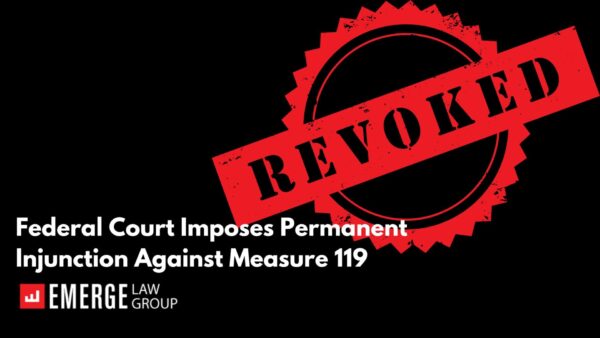The Oregon Liquor Control Commission (“OLCC”) recently published several amendments to its regulations that will go into effect on February 1, 2020. If you operate an OLCC-licensed recreational marijuana business, some of these amendments may have a significant effect on your operations. Please see our summary below of the key changes. We strongly recommend that you carefully review all rule changes listed on the OLCC website here.
- “Financial interest” definition expanded to include adults who share the same permanent address with an applicant or licensee.
- “Points of ingress and egress” definition expanded to include “any point that may be reasonably used by an individual to enter into an area,” including “windows,” “crawlspace access points,” and openings whether or not those points are secured by a locked door, window, or means capable of being unlocked or unsealed by a key, code, or other method intended to allow access.”
- This expanded definition may require increased camera coverage for locations that were not previously considered “points of ingress and egress.”
- Producers who do not own the property on which their premises sits must obtain and submit a form to OLCC signed by the owner of the property consenting to production of marijuana on the premises.
- Pending applications of all license types may no longer change ownership prior to licensure.
- If a licensee loses access to its licensed premises, OLCC may allow a change of location of the licensed premises if licensee submits notice at least 15 days prior to loss of access, removes all marijuana items prior to loss of access, is not under investigation for suspected violations, can prove legal access to new property within 30 days of loss of access, and submits a Land Use Compatibility Statement (“LUCS”) for the proposed location.
- Trade sample limits increased (check rules for precise amounts) and there are new Metrc requirements for designating trade samples.
- New Metrc requirements for providing employees with quality control samples.
- Retailers may now store marijuana items – except for immature plants – in a locked, secured location within a limited access area not visible from outside the premises (rather than in a safe or vault).
- All cameras now required to have minimum resolution of 1280×720 px and record at 10 fps regardless of coverage location.
- Canopy Areas:
- If using a racking system, total canopy area of mature plants is measured to include each layer of plants as a separate canopy area.
- Canopy areas (up to 20 total for immature and mature canopies) must be clearly demarcated with a physical boundary, wall, or marker at the outermost edge or each corner of each designated canopy space.
- Producer licensed for at least one year may now request an increase in tier at any time after the first license year (rather than only at renewal).
- Producers now must, within 45 days of harvest, record moisture loss by marking the harvest as complete in Metrc.
- Changes to UID tag procedures (consult appropriate rule for details).
- Reconciliation of inventory and weights with Metrc may now be completed by 8 am the next day (rather than the same day).
- Licensees may now transport marijuana items during a period of 60 hours, including overnight stops. Consult appropriate rule for further changes to transportation requirements.
- Potential fines have increased depending on license and violation type (consult appropriate rule for details).
If you have questions about any rule changes or any other compliance questions, please contact one of Emerge’s compliance experts.





